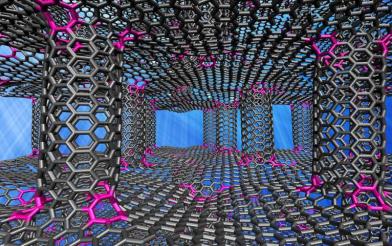In early October 2017 we posted about Nanotech Engineering's novel graphene-enhanced solar panel, a post that raised many eyebrows. Nanotech says that their graphene panel reaches a 92% efficiency (compared to around 20% for large commercial silicon-based PV panels), and the cost per Watt of their panel will be 0.55 cents (compared to a US average of $3.26 for silicon PV panels).

Graphene-CNT junctions (source: Rice University)
Our post quoted Nanotech's PR, stating that Jeffrey Grossman, Professor of Engineering at MIT verified the technology and said that Pound for pound, the new solar cells produce up to 1,000 times more power than conventional photovoltaics.
Our article received many responses - most of them declaring this news as a hoax: 92% is a theoretically impossible feat and that the MIT professor quoted in the company's PR says he has no connection to this tech. Considering Graphene-Info's place as an objective news hub, we cannot vouch for anything so we simply reached out to Nanotech to hear more about the business and technology and their reply to the issues above. Following is the information we got from the company - we posted it as is, without any commentary or opinion of our own,
So first of all, Nanotech's panels are reportedly built from ten layers of graphene and a carbon nanotube forest on top. The CNTs convert the photons to electrons while the graphene is the conducting layer. The company says that this structure enables the high conversion efficiency - while still being very cost effective.
Our readers pointed out the Schockley-Queisser limit - according to research the maximum theoretical limit of PV efficiency is 86.8%. Nanotech, however, says that this limit is only applicable to Silicon, but for Carbon Nanotubes and graphene it does not hold.
Regarding MIT, Nanotech admits that this was a mistake. The original post came from their advertising company which made a wrongful statement. Nanotech later removed that article and post. The quote from MIT was correct - but it had no relation to Nanotech's technology - it was about graphene solar potential in general.
Nanotech posted the technical specification of their panels - actually stating that the cell efficiency is 96.9% and the module efficiency is 94.7%. These results are from the company's own testing, and it has signed up for a third-party test by Intertek which will inspect the panels and provide its own results. The Intertek results are expected within a few months. Towards the end of 2017 Nanotech received its first panel samples, and posted the video you can see below.
Finally, the company updated us that they are currently in the process of finalizing a financing round, which they hope will bring in $30 million to enable them to commercialize the panels. Nanotech is also looking into other graphene applications, including composite materials.

